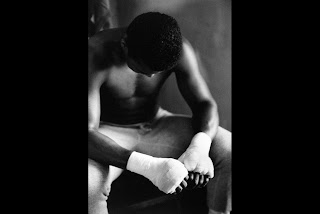Ali and Presley: Exhibition of American Icons at the James A. Michener Art Museum
 |
| Muhammad Ali, c. 1970, Gordon Parks, courtesy of the Howard Greenberg Gallery, New York, N.Y. |
Elvis at 21: Photographs by Alfred Wertheimer:
Freelance photojournalist Alfred Wertheimer was hired by RCA Victor in 1956 to shoot promotional images of recently signed 21-year-old recording artist Elvis Presley. Wertheimer's instincts were to "tag along" with the artist after the assignment and the resulting images provide us with a look at Elvis before he exploded onto the scene and became one of the most exciting performers of his time.
Elvis at 21: Photographs by Alfred Wertheimer was developed collaboratively by the Smithsonian Institution Traveling Exhibition Service, the Smithsonian's National Portrait Gallery and the Govinda Gallery. Elvis at 21 will travel to museums around the country through 2013.
Wertheimer had unparalleled access and documented Elvis on the road, backstage, in concert, in the recording studio and at home in Memphis, Tenn. "Colonel" Tom Parker, Elvis' manager, restricted contact just a short time later. The photographs document a remarkable time when Elvis could sit alone at a drugstore lunch counter.
"Henri Cartier-Bresson was known for photographing the decisive moment, that moment when everything falls into place," said Wertheimer. "But I was more interested in the moments just before or just after the decisive moment."
Wertheimer was up close to capture a flirtatious encounter with a young woman backstage in Richmond, Va. He was in the New York City recording studio on the historic day Elvis recorded "Don't Be Cruel" and "Hound Dog." Both songs hit No. 1 on the charts, the first and only time a single record would achieve this distinction.
Wertheimer also joined Elvis after the recording session as he traveled home to Memphis by train. One image shows Elvis as just part of the crowd surrounding a lunch vendor on a train platform during a brief stop on the 27-hour trip. The anonymity he had during this stop was short-lived; the trip followed a busy few months when Elvis appeared on the television shows "Stage Show," "The Milton Berle Show" and "The Steve Allen Show." The photographs of a concert in Russwood Park on his return to Memphis show a young man who now had to have a police escort to get through the crowd of fans between his car and the stadium.
Muhammad Ali: The Making of an Icon chronicles the life and times of the now-iconic figure who was simultaneously the most beloved and most reviled man in boxing and who still engenders a strong emotional response from people almost 50 years after his initial rise to public prominence.
Cassius Clay entered into American public consciousness as a fun-loving, family- oriented, clean-living and patriotic young man. "From his early years as a fast-talking young boxer, to his courageous stance at the forefront of the anti-Vietnam War movement, to his most recent role as a respected spokesman for Parkinson's disease, Muhammad Ali's charismatic and often outrageous personality makes a profound impression on everyone he meets," says Hava Gurevich, curator, Muhammad Ali: The Making of an Icon.
The exhibit, organized by art2art, provides a glimpse of rarely seen moments of his personal life as well as more famous episodes from his career. These images not only illustrate the enormous changes that he went through—from a patriotic Olympic champion to a draft-resisting member of the Nation of Islam to a figure of racial reconciliation—but also show that Ali's gregarious, funny and likable personality remained intact even as a super-charged political atmosphere swirled around him.
Ali's story is one of an American hero who has come full circle in the hearts and minds of people throughout the world, and features more than 50 photographs by such distinguished photographers as Annie Leibovitz, Gordon Parks and Art Shay that capture Ali's positive public image. Although his braggadocio and vanity flouted conventional ideas about sportsmanship, the overall sense was that Ali was a "good kid" who valued family and community and was using boxing to earn a share of the American Dream.
Cassius Clay began boxing in 1954 after his bicycle was stolen in his hometown, Louisville. He wanted to learn the sport in order to beat up the culprit when he found him. Although he never figured out who took the bike, 10 years later Clay would be the heavyweight champion of the world.
The 1960s and 1970s were super-charged political times, and Ali became one of the most important symbols of his generation. Following his 1964 title win over Sonny Liston, he announced that he belonged to the Nation of Islam. In 1966, following his reclassification as draft-eligible for military service in Vietnam, he publicly opposed the war. As a result of his defiance, Ali was barred from boxing for three-and-a-half years and was convicted for draft evasion. By the time he reclaimed the championship in 1974, Ali was idolized by millions of people around the world.


Comments
Post a Comment